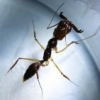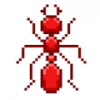Hi! I've made a type of formicarium that seems to suit ants pretty well. After a request, I've decided to create a topic for the instructions.
This formicarium is good for those of you who want a natural looking formicarium or for those people who like the nice sand/dirt nest setups.
This nest is great for semi-claustral and claustral queens, full colonies, founding colonies, and even subterranean termites.
See bottom for twig nesting species instructions.
Step 1: Preparation
First, get a container of some sort, but make sure that it can fit up to two test tubes in them. Make sure you ant proof it by making a barrier or providing a lid with stainless steel mesh. This part is definitely the most expensive of all the other steps. You can also use an ant-proofed aquarium or critter keeper.
Step 2: Laying the Foundations
Now, layer tissues, toilet paper (any type of soft tissue) or cotton on the bottom for about half an inch. This will be the base of your ant farm. Now dampen the tissue and flatten it completely.
Step 3: Providing some water
As a good amount of you know, humidity is incredibly important for ants. Place a test tube/glitter mixing tube full of water and plugged with cotton in the container. Make sure the cotton plug lines up with the middle of your formicarium. You don't have to add the tube if you have a dry-nest species. The humidity from the tissues added will be good enough.
Step 4: More Foundations
Add some more tissues/cotton over/around the test tube, and place them as much as you want. Leave some space over/around the entrance and cotton of the test tube. Note: When you dampen and compress the tissues/cotton, the volume occupied by cotton is much less. Make sure you add some more than you want at the moment.
IMPORTANT! Get chopsticks, pencils, or some other tool to leave some empty space between the other tissues you add over the test tube. Make sure that the hole is AT LEAST four inches by four inches, and it should go down to the foundation from step 2. Also, make sure the damp cotton from the test tube is exposed.
Step 5: Adding Some Dirt
Now add some damp dirt. The dirt can be seedling potting soil (no fertilizer or anything like that) or just some soft soil from outside. Pour that dirt in the hole that you left until the dirt is level with the cotton/tissues. Try not to let dirt spill anywhere other than the hole because some say it looks better like that.
Step 6: Preparing the setup
Now get some tissues and place them over the dirt. Make a hole that your ants can fit through in the thin tissue layer. Try to make the hole up against the container to allow easy ant visibility.
Now, using a tool that is roughly the diameter of your ants, make a hole (maybe diagonal for weak climbers) in the dirt to give your ants somewhere to start digging.
Step 7: Decorating
For those of you who want to enhance the looks of your finished ant farm, you can add a thin layer of different colored dirt/moss around the hole. That way you can easily see the anthill that your ants might make in the future (some ants don't really make anthills). You can also add a plant in the damp tissues (possibly with aphids). Rocks can be added also, but your ants might burrow under the rocks and make visibility difficult.
For Twig Nesting Ants
Step 1 is the same
Step 2: Adding some dirt
Add the same dirt as mentioned above. The dirt is just decoration, so make it as thick as you want it to be.
Step 3: Adding a stick
Now add a hollow branch, You can use a stick of bamboo or just a random stick hollowed out by wood borers. Make sure that the stick isn't from a poisonous plant. You can either prop the stick up on the side or wedge the end of it in the dirt and cotton.
Step 4: Decoration
See Step 7 above
Questions? Comments? Pictures? Clarifications? Let me know in the comments and I can help.
Thanks for reading this! ![]()
Part of me feels like I forgot something...























